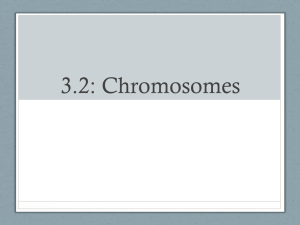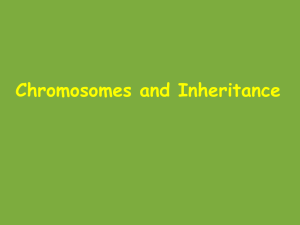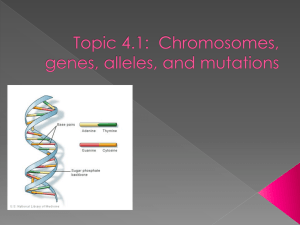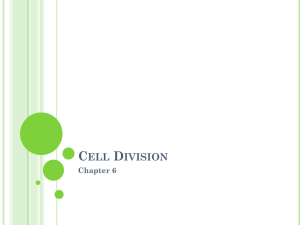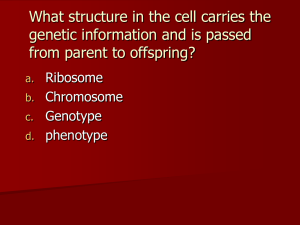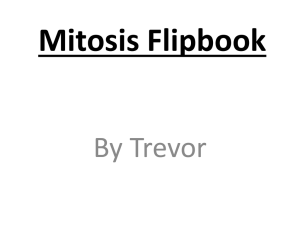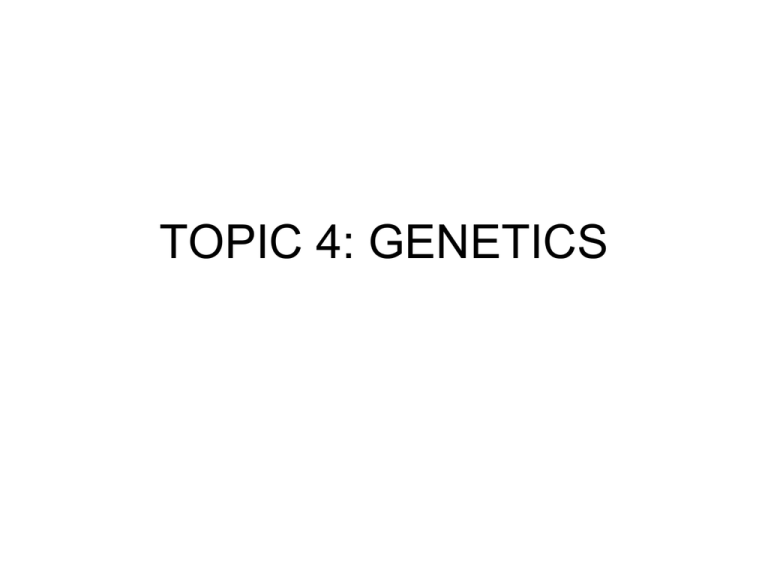
TOPIC 4: GENETICS
4.1: Chromosomes, genes, alleles
and mutations
4.1.1 Eukaryotic chromosome
STATE: Eukaryotic chromosomes are made of DNA and proteins
4.1.2: Gene
Define gene: A heritable factor that controls a specific
characteristic. It is a section of DNA that codes for making one
or more polypeptides.
4.1.2: Allele
Define allele: One specific form of a gene, differing from other alleles by one or a few
bases only and occupying the same gene locus as other alleles of the same gene.
4.1.2: Genome
Define genome: The whole of the genetic information of an organism
4.1.3: Gene Mutation
Define mutation: A change in the base sequence of a gene
4.1.4:Sickle cell anaemia
CCU
amino
acids
proline
GUG
VALINE
GAG
glutamic acid
4.1.4:
4.1.4
Explain the causes of sickle-cell anemia. [8]
M11/4/BIOLO/HP2/ENG/TZ2/XX
caused by gene mutation;
(sickle-cell anemia) due to a base substitution (mutation);
changes the code on the DNA;
which leads to a change in transcription / change in mRNA;
DNA changes from CTC to CAC/GAG to
GTG / mRNA changes from GAG to GUG;
(accept DNA changes from CTT to
CAT/GAA to GTA / mRNA changes
from GAA to GUA)
which (in turn) leads to a change in translation / change in polypeptide chain/
protein;
(the tRNA) adds the wrong amino acid to the polypeptide chain;
glutamic acid replaced by valine;
produces abnormal hemoglobin;
causing abnormal red blood cell/erythrocyte shape / sickle shape;
which lowers the ability to transport oxygen;
sickle-cell allele is codominant;
homozygote/HbS HbS have sickle cell anemia/is lethal / heterozygote/HbS HbA has
the sickle trait/is carrier (and is more resistant to malaria);
Explain the cause of sickle cell anemia and why it has been selected through natural
selection.
[8] M08/4/BIOLO/SP2/ENG/TZ1/XX+
Explain the effect of base substitution
mutation in sickle cell anemia.
[3] N07/4/BIOLO/HP2/ENG/TZ0/XX+
One homologous pair of chromosomes in
their non-duplicated form
Two homologous pairs of chromosomes.
Chromosomes are shown in their duplicated form.
DNA Replication
Define: Homologous chromosomes: matching pairs of chromosomes
4.2: Meiosis
STATE: Meiosis is a reduction division of a diploid nucleus to form haploid nuclei
Diploid: # of chromosomes in a body
(somatic) cell (2n)
Haploid: # of chromosomes in a sex cell (n)
Prophase I of Meiosis I
Homologous
chromosomes pair up
forming a synapsis and
crossing over occurs
Nuclear membrane
breaks down
Chromosomes
condense and
supercoil
Spindle microtubules
develop from the
centrioles.
Metaphase I of Meiosis I
Microtubules attach to
chromosomes.
Homologous
chromosomes are
“pushed and pulled”
by microtubles to the
equator of the cell.
Anaphase I of Meiosis I
Homologous
chromosomes
separate and are
pulled to opposite
poles.
Chromosomes are still
in their duplicated
form.
Cytokinesis occurs
Telophase I of Meiosis I
Chromosomes arrive at
the poles
Chromosomes number
is reduced by half.
Chromosomes uncoil
New nuclear membrane
reforms.
Microtubules break down
Prophase II of Meiosis II
Nuclear membrane breaks down
Chromosomes supercoil
Centrioles move to the poles and
spindle microtubules develop
Metaphase II of Meiosis II
Spindle microtubules attach to
chromosomes and move
chromosomes to the equator of the
cell
Anaphase II of Meiosis II
Sisiter chromatids separate (and
are now are called chromosomes)
are pulled towards opposite poles
Telophase II of Meiosis II
Chromosomes uncoil
Nuclear membrane
reforms
Cytokinesis
Meiosis: Type of nuclear division in which one parent diploid
nucleus divides into four daughter haploid nuclei, each
genetically different to each other.
DNA replication in the S-phase of
interphase
Homologous
chromosomes separate in
meiosis I
Sister chromatids
separate in meiosis
II
A
a
A
A
a
a
A
a
A
AA
Aa
a
Aa
aa
4.2.1: Meiosis
4.2.2: Homologous Chromosomes
4.2.3: Process of Meiosis
4.2.3: Crossing over
4.2.3: Stages of Meiosis
4.2.4: Non-disjunction
Fertilization following Meiosis II error:
Trisomy 21: Down syndrome
What should happen
Non-disjunction
http://www.biostudio.com/d_%20Meiotic%20
Nondisjunction%20Meiosis%20II.htm
http://www.biostudio.com/d_%20Meiotic%20
Nondisjunction%20Meiosis%20I.htm
4.2.5: Karyotyping
STATE: In karyotyping, chromosomes are arranged in pairs according to their size and
structure
Normal Male
Normal Female
Chromosomes in their duplicate
form
Gorilla Karyotype
Dog Karyotype
Sheep Karyotype
What is wrong here?
Down Syndrome
Describe the causes of Down syndrome. [5] M11/4/BIOLO/HP2/ENG/TZ2/XX
Down syndrome is caused by non-disjunction;
occurs during meiosis;
chromosome pairs fail to separate in meiosis I / chromatids in meiosis II /
anaphase II;
some gametes have an extra chromosome;
can lead to zygotes/individuals with an extra chromosome / individual has
47 chromosomes;
in Down syndrome this would be trisomy 21/extra chromosome 21;
increased probability with increased age of mother/ages of parents; [5 max]
The karyotype below shows the chromosomes from a person with Down syndrome.
M11/4/BIOLO/SP2/ENG/TZ2/XX
(a) State the evidence provided by the karyotype that shows this person has Down
syndrome. [1]
(b) Outline how Down syndrome occurs due to meiosis. [2]
(c) Determine, giving a reason, the sex of the person in the karyotype. [1]
(d) Explain briefly why males are more likely to inherit colour blindness than females. [2]
Explain how an error in meiosis can lead to Down syndrome. [8]
M10/4/BIOLO/HP2/ENG/TZ2/XX+
non-disjunction;
chromosomes/chromatids do not separate / go to same pole;
non-separation of (homologous) chromosomes during anaphase I;
due to incorrect spindle attachment;
non-separation of chromatids during anaphase II;
due to centromeres not dividing;
occurs during gamete/sperm/egg formation;
less common in sperm than egg formation / function of parents' age;
Down syndrome due to extra chromosome 21;
sperm/egg/gamete receives two chromosomes of same type;
zygote/offspring with three chromosomes of same type / trisomy / total 47
chromosomes; [8 max]
Accept the above points in an appropriately annotated diagram.
What’s wrong?
What’s wrong here?
Klinefelter’s Syndrome
What’s wrong?
Patau’s Syndrome
Chronic Myelogenous Leukemia
(CML)
Triploid Karyotype
What’s the problem?
What are the Symptoms of
Edwards Syndrome?
• About 25% of Edward's
syndrome victims die
before they are one
month old,
• 10% live for one year.
Symptoms
*Growth deficiency
*Breathing difficulties
*Developmental delays
4.2.6:
STATE: Karyotyping is performed using cells collected by chorionic villus
sampling or amniocentesis, for pre natal diagnosis of chromosome
abnormalities.
4.3: Theoretical Genetics
4.3.1:Genotype / Phenotype
Genotype: The combination of alleles an individual has for a
particular characteristic
Phenotype: The physical appearance of a feature
4.3.1:Dominant / Recessive Alleles
Dominant allele: an allele that has the same effect on the phenotype whether it is
present in the homozygous or heterozygous state.
Recessive allele: an allele that only has an effect on the phenotype when present in
the homozygous state.
brown eyes
brown eyes
blue eyes
4.3.1: Co-dominant alleles
Codominant alleles: pairs of alleles that both affect the phenotype when present in a
heterozygote.
4.3.1: Locus
Locus: The particular position on homologous chromosomes of a gene.
4.3.1:Homozygous / Heterozygous
Homozygous: Having two identical alleles of a gene.
Heterozygous: Having two different alleles of a gene.
4.3.1:Carrier
Carrier: an individual that has one copy of a recessive allele that causes a genetic
disease in individuals that are homozygous for this allele.
4.3.1:Test Cross
Test cross: testing a suspected heterozygote by crossing it with a known homozygous
recessive.
4.3.2: Punnett Grid
4.3.3 and 4.3.4: Multiple Alleles and Blood groups
STATE: Some genes have more than two alleles (multiple alleles)
4.3.5: Sex chromosomes
4.3.6: Sex linkage. Genes carried on the sex
chromosomes
STATE: Some genes present on the X chromosome are absent from the shorter Y
chromosome
4.3.7: Sex linkage
STATE: A human female can be homozygous or heterozygous with respect to
sex-linked genes.
4.3.8: Sex linked diseases
Sex Linked disease
Explain, using an example, how females
but not males can be carriers of some
recessive alleles. [4]
M11/4/BIOLO/SP2/ENG/TZ1/XX
M10/4/BIOLO/HP2/ENG/TZ2/XX+
4. (a) Explain why carriers of sex-linked (X-linked) genes must be
heterozygous.
[2]
(c) Describe the inheritance of colour blindness in humans.
M09/4/BIOLO/HP2/ENG/TZ2/XX
4.3.12: Pedigree Chart
4.4 Genetic Engineering and
Other Aspects of
Biotechnology
4.4.1: PCR (polymerase chain reaction)
4.4.2: Gel Electrophoresis
State: that, in gel electrophoresis, fragments of DNA move in an electric field
and are separated according to their size.
Person A
Person B
DNA cut with restriction enzyme
3 fragments
2 fragments
4.4.3 and 4.4.4: DNA Profiling
STATE: Gel electrophoresis of DNA is used in DNA profiling
Explain the methods and aims of DNA profiling. [8] M10/4/BIOLO/HP2/ENG/TZ1/XX
4.4.5: DNA profile
The diagram below represents the results of a paternity investigation. Track A is the
profile of the mother of a child, track B is the profile of the child and track C is the profile
of a man who might be the father. M11/4/BIOLO/SP2/ENG/TZ1/XX
Explain, using evidence from the diagram, whether this man is the father or not. [3]
M11/4/BIOLO/SP2/ENG/TZ1/XX
N07/4/BIOLO/SP2/ENG/TZ0/
The diagram below shows a DNA profiling of a family with five children. Segments of the
DNA inherited by some members of the family are shown as two dark bands in each
column.
The DNA fragments are labelled A to F.
(a) State two properties of the fragmented pieces of DNA which allow them to be
separated in gel electrophoresis.
b. Determine which DNA fragment Son 2 inherited from his mother and which from
his father.
From his mother: . . . . . . . . . . . . . . . . . . . . . . . . . . . . . . . . . . . . . . . . . . . . . . . . . . . . . . . .
From his father: . . . . . . . . . . . . . . . . . . . . . . . . . . . . . . . . . . . . . . . . . . . . . . . . . . . . . . . . .
c. Identify the child that genetically most resembles one of the grandparents. [1]
d. Apart from determining family relationships, outline one other application for
DNA profiling.[1]
4.4.6: Human Genome Project (HGP)
4.4.6: Possible Advantages to the HGP (know three of these)
Improves our ability to conduct genetic screening for
genetic disorders.
Improves our ability to develop new drugs for genetic
diseases. (Molecular medicine).
Improves our ability to use DNA in the study of evolution
and human dispersal out of Africa.
Match organ donors with recipients in transplant
programs.
Elucidating the function of the large proportion of DNA
we know little about.
4.4.7: Gene Transfer
4.4.7:
Transfer of Genetic Material
Across Species
(b) (i) Label the diagram below which shows a basic gene transfer. [2]
(ii) State two general types of enzymes used in gene transfer.[1]
(a) Gene transfer to bacteria often involves small circles of DNA into which genes can be
inserted. State the name of a small circle of DNA, used for DNA transfer, in bacteria.
(b) The diagram below shows a cut circle of DNA into which a gene is being inserted.
Before
it can be transfered into a bacterium, the ring must be altered, using an enzyme.
M10/4/BIOLO/SP2/ENG/TZ1/XX
Outline what must be done next to complete the process of gene insertion into the
DNA circle, including the name of the enzyme that is used.
[2]
(c) Discuss the potential benefit and possible harm of one named example of gene
transfer between species.
4.4.7: Transfer of Genetic Material Across Species
State: That, when genes are transferred between species the amino acid sequence of
polypeptides translated from them is unchanged- because the genetic code is universal.
4.4.8: Gene Transfer
State: that, when genes are
transferred between the amino acid
sequence of polypeptides translated
from them is unchanged- because
the genetic code is universal.
The diagram below shows a cut circle of DNA into which a gene is being inserted.
Before it can be transferred into a bacterium, the ring must be altered, using an enzyme.
M10/4/BIOLO/SP2/ENG/TZ1/XX
Outline what must be done next to complete the process of gene insertion into the
DNA circle, including the name of the enzyme that is used. [2]
Discuss the potential benefit and possible harm of one named example of gene transfer
between species. [3]
Outline a basic technique for gene transfer involving plasmids. [6]
M08/4/BIOLO/HP2/ENG/TZ2/XX
4.4.9: State two examples of Genetically Modified Crops or
Animals
GOLDEN RICE
Golden rice is a variety of rice that has been genetically modified to produce betacarotene (a precursor of vitamin A). Golden rice has the potential to prevent blindness or
death in populations with vitamin A deficiency.
BT CORN
BT corn is a variety of corn that has been genetically modified to produce a bacterial
toxin. The toxin is not harmful to people but it kills caterpillars. The advantage of BT corn
is that it doesn't need to be sprayed with pesticides.
4.4.10: Benefits/Harmful Effects of GMOs
Advantages of Genetically Modified corn are: 1) it increases profits for farmers by saving
them the expense of spraying pesticides; 2) it keeps the price of corn lower for
consumers; and 3) it saves the environment from toxic pesticides, which can pose heath
risks to people and can kill non-target species that with important roles in the ecosystem.
Disadvantages are: 1) insect pests may develop resistance to the GM corn because
continual exposure to the toxins will speed up the rate of natural selection; and 2) GM
corn may produce toxic pollen, release it into the air, and harm beneficial species like the
monarch butterfly(although recent studies do not support this claim).
Genetic modification involves the transfer of DNA from one species to another. Discuss
the potential benefits and possible harmful effects of one example of genetic
modification in a named organism. [8] M07/4/BIOLO/SP2/ENG/TZ1/XX
Two examples of genetically modified crops or animals
1. Bt Maize
2. Golden rice
Describe the genetic modification to produce Bt Maize
Potential Benefits of Bt Maize
Possible harmful effects of Bt Maize
4.4.11: Clone: Genetically identical organisms or a group of cells
derived from a single parent cell.
4.4.12: Outline a techniques for
cloning using differentiated animal
cells
4.4.12: Cloning using Differentiated Cells
4.4.13: Ethical Issues in Therapeutic Cloning in Humans
Therapeutic cloning is the creation of an embryo to
supply embryonic stem cells for medical use.
4.4.13: Discuss ethical issues of therapeutic cloning in humans
What is therapeutic cloning?
Arguments for therapeutic cloning
Arguments against therapeutic cloning

